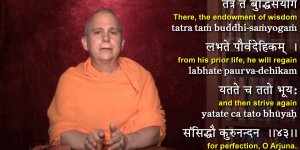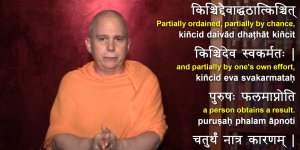| TV Channels / Documentaries |
The Inner Journey: A Course in Meditation
Part 1: What Meditation Is and Is Not
A video presentation by Swami Tadatmananda Saraswati, Arsha Bodha Center, United States
(Tapescript) Welcome to this course on meditation.
To ask, What is meditation? is like asking, What is science? or "What is music?"
It's impossible to express the vastness and depth of subjects like these in just a few words.
Meditation isn't simply a mental discipline or practice of quieting your mind. It's also a profound spiritual inquiry that turns your attention inwards to help you discover hidden truths about your true nature.
Meditation is also a contemplative art. It allows you to explore wonderful inner realities, painted as it were, on the canvas of your mind.
More importantly, meditation is a journey. It's a path of sacred wisdom and spiritual growth that can lead you towards enlightenment.
But, describing meditation like this is like trying to describe the flavor of a juicy peach. Words are no substitute for your own direct experience. But that doesn't mean words are useless. After all, words can tell you how to select the ripest fruit from a bushel of peaches.
In the same way, the teachings presented in this course can introduce you to a wide range of meditation techniques and enable you to select those best suited for your personal needs and individual temperament.
The ultimate goal of these lessons is to help you develop a powerful and rewarding practice of meditation.
Meditation has been practiced for millennia, and not just by Buddhists and Hindus. Followers of every religious faith and spiritual tradition practice some kind of meditation. And not all of them live in remote monasteries and ashrams, secluded from worldly activities. Meditation is meant for everyone, for people of all walks of life.
I learned this in the 1970 s when I lived in California and worked as a computer engineer. In those days, the first yogis and swamis from India had just begun to arrive in the U.S.
Some of them landed on the shores of sunny California, providing me with a great opportunity for spiritual study.
I grew up in the 1960's, which was a turbulent time in this country. Like many of my generation, I had abandoned the Christian religion of my childhood and was interested in Eastern Spirituality, as we called it then. I attended classes on yoga and meditation taught by several swamis and their American disciples.
My practice back then was very basic - just a few yoga postures, breathing exercises, and simple meditation techniques. But in spite of being a complete novice, that practice helped me a lot, and in ways that I didn't expect, like at work.
Every week, I attended meetings with managers and engineers, most of whom were male, highly competitive, and strongly opinionated. In those meetings, raised voices and strident arguments were common.
Most of the time, I remained quiet and listened carefully, while reviewing documents.
Our department manager apparently took note of my silence and he began to ask for my views after each meeting. Perhaps he considered my observations to be more accurate and objective than the noisy opinions of others.
Before learning to meditate, I used to argue just as stridently as everyone else in those meetings. But my modest practice produced some surprising changes in my thinking and behavior.
I realized that if a little meditation could be so beneficial, then developing my practice further could help much more. That reasoning led me to begin a journey of spiritual growth.
My path led me from one guru to another for several years.
Then in 1981, I met Swami Dayananda, a traditional teacher of advaita Vedanta, an ancient Hindu spiritual teaching that's often called the epitome of Indian philosophy.
Under Swami Dayananda's guidance, I learned Sanskrit, studied sacred texts, and meditated while living in his ashrams in India and the U.S. Twelve years later, he initiated me as a sannyasi, a Hindu monk, on the banks of the Ganges River.
It might seem strange for an American computer engineer to end up as a Hindu spiritual teacher.
But, like anyone else, I simply pursued what was most valuable to me.
In the teachings of Vedanta and in the practice of meditation, I found such extraordinary value that it was only natural to devote myself to those pursuits.
It's also natural for me to share the teachings and practices that have helped me so much over the years.
There are many misconceptions and incorrect assumptions about meditation. These wrong ideas can get in the way of proper understanding, so before we continue, let's address some of the most common misunderstandings.
Many people seem to think that meditation is just emptying the mind, making it silent or blank.
But in the majority of meditation techniques, you actually engage your mind in a specific activity, like mentally reciting a mantra or observing your thoughts. And you can't do that with a silent mind.
Some people assume that meditation is basically a way to experience bliss. Meditation can certainly make you blissed-out, as they say, but that experience lasts only until you open your eyes. Besides, there's so much more to be gained than a few moments of bliss.
Sometimes, the goal of meditation is described with overblown language as being a supreme, ecstatic, transcendent state of superconsciousness. Descriptions like these seem like attempts to make meditation appear fascinating and highly exotic. But to me, these words sound more like the jargon and hype you find in television commercials. We don't need advertising; we need clear and correct guidance.
Another fallacy is that meditation is a misguided attempt to escape the problems of life, like troubles with your family, work, finances, and so on. After all, when your meditation session comes to an end, all your problems remain unchanged, and unresolved.
Obviously, meditation can't solve all your problems, but it certainly can energize and rejuvenate you. Certain practices can empower you to deal with life's challenges more effectively.
Sometimes, we need to temporarily withdraw and recharge our batteries, so to speak, like we do while sleeping each night. Sleep and meditation are certainly not escapes; they prepare and strengthen us for the struggles that lie ahead.
The last misconception we'll consider here is the notion that meditation is a selfish or self-centered pursuit.
If you see a meditator, sitting alone with her eyes closed, and smiling as peace and happiness fill her heart, it would be wrong to conclude that she's somehow self-obsessed, because after meditating, she can share all that peace and happiness with others.
It's a fact of life that you can only give to others what you yourself possess. You can share your money, car, and house only after you've acquired them.
In the same way, you can share happiness, love, and joy only when you yourself possess them. The more inner peace you discover in meditation, the more you have to share with others.
This principle has a dark flip side. Anything undesirable that you possess can also be shared with others. For example, when you get a nasty cold, you might very likely give it to friends and family. Or, if you're in a really bad mood, those closest to you will probably get affected by it. And if your heart is full of anger, hurt, or sadness, all that will get passed on to others, whether you want to or not.
Meditation can't help you avoid a cold, but it can help free you from dark moods and negative emotions. In this way, meditation can enable you to share the best of yourself with others in your life.
In the next lesson, we'll discuss the ancient origins of meditation and the different practices that evolved over the centuries.

Subscribe now to get unrestricted access to all resources, in all languages, throughout this web site!
Subscription Form
YOU MAY ALSO LIKE






Subscribe now to get unrestricted access to all resources, in all languages, throughout this web site!
Subscription Form
